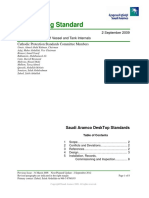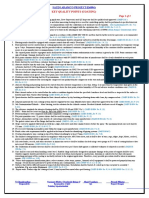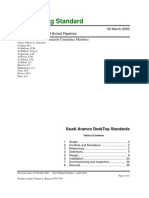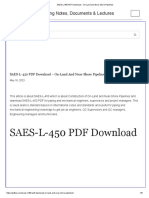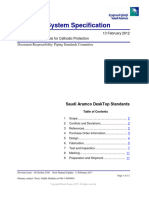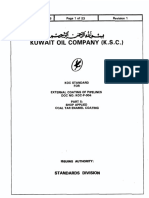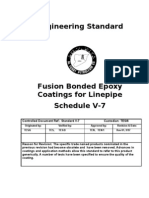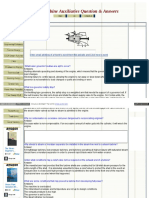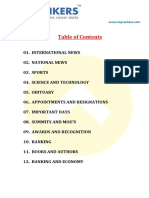Pipe Coat & Lining
Pipe Coat & Lining
Uploaded by
jadav parixeetCopyright:
Available Formats
Pipe Coat & Lining
Pipe Coat & Lining
Uploaded by
jadav parixeetOriginal Description:
Copyright
Available Formats
Share this document
Did you find this document useful?
Is this content inappropriate?
Copyright:
Available Formats
Pipe Coat & Lining
Pipe Coat & Lining
Uploaded by
jadav parixeetCopyright:
Available Formats
Engineering Encyclopedia
Saudi Aramco DeskTop Standards
Pipeline Coatings and Linings
Note: The source of the technical material in this volume is the Professional
Engineering Development Program (PEDP) of Engineering Services.
Warning: The material contained in this document was developed for Saudi
Aramco and is intended for the exclusive use of Saudi Aramcos
employees. Any material contained in this document which is not
already in the public domain may not be copied, reproduced, sold, given,
or disclosed to third parties, or otherwise used in whole, or in part,
without the written permission of the Vice President, Engineering
Services, Saudi Aramco.
Chapter : Paints & Coatings
File Reference: CEO10809
For additional information on this subject, contact
A.A. Al-Madhlouh on 873-8540
Engineering Encyclopedia
Paints & Coatings
Specifying Scale Inhibitor Programs
CONTENTS
PAGES
Cathodic Protection - Underground Pipe ......................................................................... 1
Fusion Bonded Epoxy - Pipe Coating.............................................................................. 1
FBE Requires Strict Quality Control ............................................................................... 2
Hot-Applied Coal Tar Enamel Pipe Coating.................................................................... 3
Coal Tar Systems - Principal Uses ................................................................................... 4
Saudi Aramco Specification - Coal Tar Enamel............................................................... 4
Storage, Handling, and Installation of Weight-Coated Pipe ............................................ 5
High Density Polyethylene Pipe Coating......................................................................... 6
Pipeline Weight Coatings ................................................................................................ 6
Internal Pipeline Coatings - Saudi Aramco ...................................................................... 7
Internally Lined Pipe........................................................................................................ 7
Plastic Internally Coated Pipe .......................................................................................... 8
FBE Internal Pipe Linings................................................................................................ 8
Cement Mortar Lined Pipe............................................................................................... 9
Other Pipeline Coatings .................................................................................................10
Conclusions ................................................................................................................... 10
Saudi Aramco DeskTop Standards
Engineering Encyclopedia
Paints & Coatings
Specifying Scale Inhibitor Programs
Cathodic Protection - Underground Pipe
Protective coatings are the primary means to resist underground and underwater corrosion. However, because of
the severity of corrosion in some areas, cathodic protection (CP) is used to supplement the coating system.
Cathodic protection is an electrochemical process in which the protected metal surface of the buried pipeline is
forced to behave as a cathode. Protective coatings and cathodic protection act synergistically to protect the
pipeline. CP will provide protection at holidays or soil-damaged areas in the coating system. Previous work has
shown that most pipeline holidays and failures are found at field girth welds because of poor surface preparation,
inadequate thickness, and improper application. However, if improperly applied, cathodic protection can have a
negative effect on pipeline durability.
CP is applied to pipelines per SAES-X-600, "Cathodic Protection In-Plant Facilities", and SAES-X-400,
"Cathodic Protection of Buried Pipelines". If the polarization potential reaches -1.2 V versus copper/copper
sulfate reference electrode, hydrogen gas may be evolved at the cathode (the coated pipeline surface). This gas
evolution can damage the pipeline coating; therefore, a pipeline protective coating system must be selected that
is resistant to this type of damage.
Fusion Bonded Epoxy - Pipe Coating
Fusion Bonded Epoxy (FBE) is the most widely used pipe coating system in Saudi Aramco facilities. It can be
used for buried and subsea pipelines up to a maximum temperature of 105C. FBE can be used subsea if a
weight coating (to provide negative buoyancy) is not used, or if the weight coating is applied by the
compression coat method. FBE is resistance to ambient and high operating temperatures, soil stress, water,
hydrocarbons, abrasion, and flexibility. The coating is usually shop-applied, but repairs can be performed in
the field with similar epoxy materials. Compared to hot-applied coal tar enamel and HDPE, it is a thin coating
system. FBE coated pipe must therefore be stored, handled, and installed more carefully in the field. The
applicable Saudi Aramco specifications for external coating of pipe with FBE are:
SAES-H-002
Internal and External Coatings for Steel Pipelines and Piping.
APCS-104
FBE - Shop or Field Applied FBE Pipe Coating.
09-SAMSS-089 - Shop Applied External FBE Coatings.
SAES-H-201
General Specification for Over-the-Ditch FBE External Coating of Field Girth
Welds.
SAES-H-200
Storage, Handling, and Installation of Pipe Externally Coated with Fusion
Bonded Epoxy or Polyetheylene.
A description of the FBE application process follows; such applications are made under very controlled
conditions because of their importance.
Saudi Aramco DeskTop Standards
Engineering Encyclopedia
Paints & Coatings
Specifying Scale Inhibitor Programs
FBE applied to pipe and equipment and to reinforcing steel for concrete construction is applied in generally the
same manner. First, the steel is decontaminated and abrasive blast cleaned to SSPC-SP-10 (SA 2 1/2). It is
then preheated by electrical induction heaters to a temperature prescribed by the epoxy coating powder
manufacturer. A differential electrostatic charge is generated between the powder application equipment and
the steel pipe or surface. Powder can then be applied uniformly and without holidays to the entire steel surface.
Inspection for holidays or damage and later repairs are made consistent with 09-AMSS-089. The dry film
thickness should be 17-22 mils. Figures 1 and 2, located in the figure sheets, are, respectively, FBE fieldapplied to pipe and a photomicrograph of an FBE internally and externally applied to a pipe wall and girth weld
section. It is important that the girth welds are coated properly because it has been shown that protective
coatings frequently fail there compared to the pipe body.
SAES-H-201 covers FBE applied to girth welds in the field. It directs that FBE be applied in the field in the
same manner as in the shop. The powder is not applied by electrostatic spray equipment, but it is blown onto
the surface. FBE is the preferred method for protecting field girth welds, but HDPE heat shrink sleeves may
also be used. See Figure 3. This application should follow APCS-110, APCS-111, and APCS-112 heat shrink
sleeve application instructions.
FBE Requires Strict Quality Control
FBE requires strict QA/QC precautions when it is applied, carried to the field, joined, and buried. These
precautions are enumerated in SAES-H-201. For example, a vendor's quality control program must include, but
not be limited to:
Pipe surface preparation and blast profile.
Abrasive blasting material and equipment.
Metal inspection.
Pipe temperature control.
Coating thickness.
Adhesion.
Holiday detection and repair.
Color, uniformity, and appearance.
Saudi Aramco DeskTop Standards
Engineering Encyclopedia
Paints & Coatings
Specifying Scale Inhibitor Programs
The inspector, in addition to assuring that these QA/QC procedures have been carried out, must spot check:
Thickness.
Adhesion.
Coating quality and repairs.
Shipment preparations.
This detailed inspection and quality control program and further inspection criteria are detailed in SAES-H-200.
After the pipeline is welded and joined in the field and the girth welds have been completely coated, the entire
surface is again inspected for holidays with a high-voltage spark test, and any holidays or damaged areas are
repaired prior to ditching the pipe. This holiday test is carried out at a potential of approximately 2400 V, a
much
lower voltage than what is specified for the hot-applied coal tar enamel or high density polyethylene coating
systems.
Hot-Applied Coal Tar Enamel Pipe Coating
Hot-applied coal tar enamel is specified for use on buried and also, on subsea pipelines, if a weight coating is
required. See APCS-106. As discussed in COE 108.02, it is a natural, convertible coating system based on the
use of coal tar pitch (a distillation product from the production of coal-based coke). It is received as a solid
block and then melted in kettles until the temperature of the coal tar liquid is approximately 375 F. It is shop
applied by a traveling weir to a length of rotating pipe. The coal tar cools and solidifies. At room temperature
it is black, glossy, hard, and very resistant to water and corrosion damage. It has been used for centuries as a
protective coating.
There are a number of components to a coal tar enamel protective coating system; these include the following:
Primer - Coal tar or synthetic primer thinly applied to a commercial abrasive blast cleaned surface.
Body Coat - Hot-applied enamel 3/32 1/32 in. thick; succeeding coats are applied 2/32 1/32 in. thick.
Reinforcement - Glass mat is wrapped into the coal tar enamel to strengthen the coating to increase
resistance to soils stress.
Saudi Aramco DeskTop Standards
Engineering Encyclopedia
Paints & Coatings
Specifying Scale Inhibitor Programs
Felt Wrapping - A coal tar saturated tape is bonded to the outer layer of the coal tar enamel to increase
resistance to damage from backfilling the pipe trench.
Kraft Paper - A heavy duty wrapping paper is applied over the completed protective coating system in
order to support the applied system until the coal tar coating has cooled, hardened, and strengthened.
Rock Shield - This is a heavy duty shielding material to prevent damage to the coating system from
falling rocks during trench backfilling.
These coatings have a long, very successful history in ambient or slightly higher than ambient temperature
service pipelines. It may be used up to 70C when buried and up to 80C subsea. However, it should not be
used when benching of the pipe is required after coating application.
Coal Tar Systems - Principal Uses
A number of hot-applied coal tar enamel systems are used by the pipeline industry. Two of the most typical
ones are shown in Figures 4 and 5. Single-coat/single-wrap and single-coat/double-wrap systems (Figure 4) are
generally used in relatively dry, sandy, or loamy soils where little soils stress is expected. SAES-H-002
specifies that this coating is suitable for temperatures of 70C onshore and 80C offshore.
A double-coat/double-wrap system is pictured in Figure 5. This is generally applied with glass mat embedded
in the first layer of hot-applied coal tar enamel and felt wrapping embedded in the second layer. This is a
heavy-duty, anticorrosive system that is used for water immersion locations or for soil burial where there may
be severe soils stress.
Saudi Aramco Specification - Coal Tar Enamel
SAES-H-002 contains some information on coal tar enamel pipe coating but detailed information on hotapplied coal tar enamel applied to pipe is contained in 01-SAMSS-012, Submarine Pipe Weight Coating. The
reasons for the inclusion of the coal tar enamel system description within this specification are:
Hot-applied coal tar coating systems are frequently used offshore.
Hot-applied coal tar coating systems are used when concrete must be applied to a submarine pipeline to
provide negative buoyancy.
Saudi Aramco DeskTop Standards
Engineering Encyclopedia
Paints & Coatings
Specifying Scale Inhibitor Programs
As specified in 01-SAMMS-012 the coating system must conform to American Water Works Association's
AWWA-C-203 -- double-coat/double-wrap -- as follows:
Primer.
Hot-applied coal tar enamel.
Glass mat wrap.
Hot-applied coal tar enamel.
Felt overwrap.
No Kraft paper wrap is applied, and the minimum coating thickness is designed to be 5/32 in.
In addition to the coal tar enamel coating, this specification also covers the requirements for the weight coating
concrete including the strength, reinforcement, and thickness (4 in. or more). The specification also sets the
requirements for placing bracelet zinc sacrificial anodes around the pipe to cathodically protect the pipeline.
Inspection procedures include, but are not limited to, requirements of AWWA-C-203 for the hot-applied coal
tar enamel coating and the purchase specification and its referenced documents for the concrete jacket coating.
Holiday detection is carried out with a high voltage spark detector at 15,000 V maximum. The compressive
strength of the concrete shall not be less than 4000 psi in order to insure a dense, strong concrete.
Storage, Handling, and Installation of Weight-Coated Pipe
The storage, handling, and installation of coal tar enamel weight-coated pipe are covered by SAES-H-220.
Note that when pipe sections are welded together, the girth weld must be protected with APCS-107 tape wrap,
which is applied in a unique manner as shown in Figure 6. After power tool cleaning (SSPC-SP-2), the tape
wrap is first applied directly over the weld; then to seal off the tar outerwrap joint, and finally over the entire
area with a 50% overlap, resulting in a minimum of two full layers of tape. To protect the tape, a heavy plastic
mesh, to be recommended by the Corrosion Control Division - Dhahran, should be applied over the taped joint.
The cavity, as shown in Figure 6, is then filled with a high density polyurethane foam encased in a steel sleeve.
This protective girth weld system is also used when weight coatings are applied with other specified subsea
coatings systems.
Saudi Aramco DeskTop Standards
Engineering Encyclopedia
Paints & Coatings
Specifying Scale Inhibitor Programs
High Density Polyethylene Pipe Coating
High density polyethylene (HDPE) pipe coating may be used for buried and subsea pipelines. If a weight
coating is needed it must be applied by the compression coat method. It can be used up to 80C service
temperature. The high density polyethylene jacket is applied in the shop to the pipe as it passes through a
plastic extrusion machine. The pipe is abrasive blast cleaned, and an epoxy primer is applied to the steel
surface. Then an ethylene copolymer adhesive is extruded onto the pipe, followed by the HDPE jacket. This
system is identified as APCS-105 in SAES-H-002, and details are given in 09-SAMSS-090, Shop Applied
Extruded Polyethylene - External Coating. A schematic of this system is shown in Figure 7 and a photograph is
provided in Figure 8. The extruded coating is applied according to manufacturer's standards; therefore, there
are no QA/QC procedures to follow.
HDPE-coated pipes are stored, handled, and installed in the field in accordance with AES-H-200. The girth
weld where pipe is joined is protected with HDPE heat shrink sleeves (APCS-111 or APCS-112, depending on
maximum operating temperatures). The details concerning application of these sleeves is given in SAES-H-204
or SAES-H-204V. Repairs to damaged areas are made with heat shrink patches or sleeves. A high voltage
(~20,000 V) spark test must be carried out to ensure that the coated pipe and welded joints are completely free
of holidays.
HDPE-coated pipe is the least used by Saudi Aramco of the three protective coating systems. HDPE-coated
pipe may be used to protect underground pipelines, but it can be used only when recommended by the
Corrosion Control Division - Dhahran. The largest application to date is the IPSA pipeline system. However,
this system is specified and used by other major oil companies worldwide. Its use in the Kingdom is sure to
grow.
Pipeline Weight Coatings
As discussed previously, weight coatings are frequently applied to subsea pipelines to provide negative
buoyancy which causes the pipeline to sink to the sea bottom. The weight coating can be applied by two
procedures. First, it can be applied by gunning or casting it into place on a rotating pipeline. Or, it can be
applied by the compression coat method by placing the concrete mix on a polyethylene outer wrap that is
applied under tension to a rotating pipeline. In the first method the concrete can impact on the pipeline and this
can damage a thin film protective coating such as FBE. This does not occur when the weight coating under
compression is wrapped onto the pipeline. This is the reason SAES-H-002 specifies compression coat weight
coating for FBE and HDPE.
Saudi Aramco DeskTop Standards
Engineering Encyclopedia
Paints & Coatings
Specifying Scale Inhibitor Programs
Internal Pipeline Coatings - Saudi Aramco
A number of protective coatings and linings for internal application to pipelines are specified in SAES-H-002:
APCS-100 - Shop Applied Baked Phenolic or Phenolic Epoxy.
APCS-101 - Shop Applied Baked Polyurethane.
APCS-102 - Shop Applied Internal Fusion Bonded Epoxies (FBE).
APCS-103 - Shop or Field Applied Cement Mortar.
APCS-100 and -101 are used principally to line oil production drill pipe or tubing. These can only be applied
in the shop because of the heat curing step. APCS-103 (cement mortar lined pipe) is used to line corroded
water pipelines onsite. The APCS-102 system is a shop-applied FBE for new pipe to be used in corrosive water
service. It is important to note that the internal pipeline coatings specified in SAES-H-002 are not considered
mandatory unless required in other specifications and documents.
Internally Lined Pipe
Pipelines are internally coated for three reasons: to resist corrosion, to improve hydraulic
flow, or a combination of both reasons. The major reason Saudi Aramco internally lines pipe is for corrosion
resistance and to control the pickup of solids in the water; improvement of hydraulic flow is of minor
importance. Characteristics of several internal pipe linings are given in Figure 9, where corroded carbon steel is
compared to pipes lined with fusion bonded epoxy, cement mortar (CML), and coal tar enamel for water
service. As shown, the linings have much better frictional flow characteristics than carbon steel. These factors
play a major role in the design of a piping system since they reduce pipe diameter and pump capacity. They
also extend useful life and reduce the need for major pipe replacement.
In the past, Saudi Aramco specified thin-film, epoxy, or epoxy copolymer linings for pipelines. These thin-film
plastic linings are no longer used because of poor performance. The main reason these linings are not used for
welded pipe is that there is no practical method for internally coating the welded girth joint. These thin-film
plastic coatings continue to be used in production for oil field tubular goods where there are no welded joints
and the pipe is joined mechanically.
Saudi Aramco DeskTop Standards
Engineering Encyclopedia
Paints & Coatings
Specifying Scale Inhibitor Programs
Plastic Internally Coated Pipe
As noted, there are three thin-film plastic linings recognized by Saudi Aramco: baked phenolic, phenolicepoxy, and polyurethane. These are all heat-cured coatings applied in multiple coats with dry film thicknesses
of approximately 9-13 mils. Figure 8 shows an internally epoxy-phenolic lined pipe in noncorrosive gas
transmission service. In this service, the lining is used to reduce friction and promote flow.
Thin-film plastic coatings are applied to pipelines and oil field tubulars in the following manner. First the pipe
is decontaminated by baking it at high temperatures ( > 700F) to burn off oil and scale. The pipe is internally
blasted to a white metal surface; in addition, chemical cleaning may be specified and then the coating is applied
by special spray equipment which deposits the coating evenly around the entire pipe circumference. The
coating is baked to some intermediate cure state and subsequent coats applied until the desired dry film
thickness is achieved. A final higher temperature bake assures complete polymerization and cure. Inspection is
required during all application steps.
The APCS specifications referenced previously for these thin-film plastic coatings contain primarily use data
such as temperature limits, suitable pH range, and environmental exposure limits including pressure and gas
concentrations. The details concerning application are contained in the SAMSS documents referenced by the
APCS specification:
Baked phenolic/phenolic-epoxy - 09-SAMSS-080 (System A).
Baked polyurethane - 09-SAMSS-080 (System B).
Specifically this document requires final inspection of the coated pipe by holiday detection, visual inspection,
dry film thickness and adhesion testing. Each of these are "special" techniques and instruction is required for
their correct use.
FBE Internal Pipe Linings
Pipe may be externally and internally coated with FBE (Figures 1 and 2). The Saudi Aramco specifications
covering both these applications are:
SAES-H-002
Internal and External Coatings for Steel Pipelines.
SAES-H-200
Storage, Handling, and Installation of Pipe Externally Coated with Fusion Bonded
Epoxy or Polyethylene.
09-SAMSS-089
Shop Applied External FBE Coatings.
09-SAMSS-091
Shop Applied Internal FBE Coatings.
Saudi Aramco DeskTop Standards
Engineering Encyclopedia
Paints & Coatings
Specifying Scale Inhibitor Programs
SAES-H-201
General Specification for Over-the-Ditch External FBE Coating of Field Girth
Welds.
Identical measures for application and quality assurance/quality control should be used for both internal lining
and external lining. If both an external coating and internal lining are applied simultaneously to pipe sections,
then both the coating and the lining must be inspected and evaluated.
If the diameter is 12 in. or greater, then the field girth weld may be coated from inside the pipe with suitable
pipeline crawlers. For detailed information concerning application and inspection, contact the responsible
organization, Corrosion Control Division - Dhahran. If the pipe is less than 12 in. in diameter, FBE internal
linings cannot be used. The pipeline must be internally lined onsite with a cement mortar lining. This type of
pipeline coating can be applied onsite to pipelines as small as 4 in. in diameter.
Cement Mortar Lined Pipe
CML pipe is also used for Saudi Aramco water services. It is also used worldwide for new construction and for
repair of existing pipelines that have suffered severe corrosion. The Saudi Aramco specifications concerning
CML pipeline applications are as follows:
SAES-H-002
Internal and External Coatings for Steel Pipelines and Piping.
APCS-103
Shop or Field Applied Cement Mortar.
01-SAMSS-005
Pipe, Cement Lined, Shop Applied.
AWWA-C-205
Cement-Mortar Protective Lining and Coating for Steel Water Pipe
- 4 in. and larger - Shop Applied.
AWWA-C-602
Cement-Mortar Lining for Water Pipelines - 4 in. (100 mm) and larger - In Place.
It should be noted that Saudi Aramco 01-SAMSS-005 is a modification or commentary on AWWA-C-205
covering shop application of CML. Therefore, both 01-SAMSS-005 and AWWA-C-205 must be must be
referred to for detailed QA/QC information. For in situ applications of CML, AWWA-C-602 must be used to
obtain detailed QA/QC information. Saudi Aramco has more in situ applications than shop applications of
CML. Figure 10 schematically illustrates in situ applications of CML to existing pipelines.
Saudi Aramco DeskTop Standards
Engineering Encyclopedia
Paints & Coatings
Specifying Scale Inhibitor Programs
CML linings are approximately 3/16-1/4 in. thick. They are recommended for most water services: salt,
aquifer, fresh, sweet, and potable water. Shop-coated pipe sections may be successfully welded in the field.
Figure 11 schematically depicts one design of a CML pipe fit up to achieve a sound weld. Other welded joint
designs for CML pipe are shown in standard Drawing L-AD-036090. Small openings at the weld of the CML
rapidly "choke" with scale and lime deposits, essentially stopping corrosion. The handling procedures detailed
in AWWA-C-205 must be followed; otherwise, flexing and bending of the CML pipe during transit will cause
early lining failure followed by pipe wall corrosion.
Other Pipeline Coatings
Other pipeline coatings such as pipeline tapes are not acceptable for use on new Saudi Aramco pipeline
facilities. Reasons for this include lack of durability and limited resistance to soil damage. In the case of
pipeline tapes, aggressive under-soil corrosion has occurred when there has been disbonding and a dielectric
barrier has formed around the pipe (Figure 12). As shown, this can occur on a pipeline that has been protected
by pipeline tape when ground water electrolytes have penetrated along the pipewall. Cathodic protection is not
effective because of the high IR drop in protective potential behind the tape; corrosion occurring behind the
tape cannot be prevented. This type of coating failure has occurred worldwide and includes Saudi Aramco,
Exxon and other facilities where extensive corrosive damage to pipelines has occurred. Pipeline tapes within
Saudi Aramco are limited to in-trench renovation coating of pipelines, as discussed in COE 108.07.
Conclusions
The preferred Saudi Aramco external pipeline coating for burial or immersion service is FBE. However, if a
FBE coated subsea pipeline requires a weight coating for negative buoyancy, it must be applied by the
compression coat method. All buried or subsea pipelines have cathodic protection applied to protect the
pipeline from corrosion at holidays or damaged areas in the coatings.
FBE is also preferred for internally lining pipe in water service if the lining will be applied in the shop. If the
pipeline is to be lined in situ, especially if the pipeline has been in service, then cement mortar linings should be
used.
For long-term durability, all internal and external pipeline coatings for use in Saudi Aramco facilities are
classified as critical coating applications.
Saudi Aramco DeskTop Standards
10
Engineering Encyclopedia
Paints & Coatings
Specifying Scale Inhibitor Programs
Photo
Figure 1. Natural Gas Pipeline. A natural gas pipeline coated with a fusion bonded
epoxy and lined with an epoxy or epoxy-phenolic coating. Note the mechanical damage to
the FBE. The internal lining protects against light rusting from the dry gas and to improve
flow of the gas through the pipeline.
Photo
Figure 2. Pipe Wall. A photomicrograph of a pipe wall coated internally and externally
with a fusion bonded epoxy. Note the uniform thickness of the coating on the pipe wall and
its lack of uniformity at the weld.
Saudi Aramco DeskTop Standards
11
Engineering Encyclopedia
Paints & Coatings
Specifying Scale Inhibitor Programs
Photo
Figure 3. Heat Shrink Sleeve. A heat shrink sleeve applied to a pipeline coated with a
fusion bonded epoxy. The pipeline has been placed in the ditch. Note the poor grade and
lack of proper bedding material.
Saudi Aramco DeskTop Standards
12
Engineering Encyclopedia
Paints & Coatings
Specifying Scale Inhibitor Programs
Single-Coat, Single-Wrap
Clean
Pipe
Coal Tar
Primer
Coal Tar
Enamel
Glass Fiber
Wrap
Coal Tar Felt
Glass Fiber
Wrap
Coal Tar
Enamel
Clean
Pipe
Coal Tar
Primer
Single-Coat, Double-Wrap
Source: Extracted from "Bitumastic Pipeline Handbook," Koppers Company,
1953.
Figure 4. Hot-Applied Coal Tar Enamel: Single-Coat Systems. Of the single-coat
systems, the single-coat/single-wrap is the most frequently used.
Saudi Aramco DeskTop Standards
13
Engineering Encyclopedia
Paints & Coatings
Specifying Scale Inhibitor Programs
Coal Tar Felt
Glass Fiber
Wrap
Coal Tar
Enamel
Coal Tar
Enamel
Clean
Pipe
Coal Tar
Primer
Double-Coat, Double-Wrap
Source: Extracted from "Bitumastic Pipeline Handbook," Koppers Company,
1953.
Figure 5. Hot-Applied Coal Tar Enamel Pipe Coating: Double-Coat/Double-Wrap
System. The double-coat/double-wrap system is used for aggressive burial or subsea
corrosive environments
Saudi Aramco DeskTop Standards
14
Engineering Encyclopedia
Paints & Coatings
Specifying Scale Inhibitor Programs
Coal Tar Coating
Concrete Weight Coating
Girth Weld
Welded Joint
Metal Mold
Saudi Aramco DeskTop Standards
Tape Wrap
Urethane Foam
15
Engineering Encyclopedia
Paints & Coatings
Specifying Scale Inhibitor Programs
Figure 6. Offshore Welded Joints. Single-Wrap with Urethane Foam Joint Filler. This schematic drawing
shows the specified procedure for protecting the girth weld of pipe coated and weight coated for subsea
application.
Saudi Aramco DeskTop Standards
16
Engineering Encyclopedia
Paints & Coatings
Specifying Scale Inhibitor Programs
Extruder
for Adhesive
SSPC
SP-10
Induction
Heating
Extruder
for HDPE
Ring Slot Die
Pipe
Movement
Primer Coating Adhesive HDPE Coating
Spray Applied
Figure 7. HDPE-Coated Pipe.
Saudi Aramco DeskTop Standards
17
Engineering Encyclopedia
Paints & Coatings
Specifying Scale Inhibitor Programs
Figure 8. Large Diameter Pipe Coated with HDPE and Lined with Baked PhenolicEpoxy. The HDPE is ~ 6 mm thick. The baked phenolic-epoxy pipe lining is applied to
decrease frictional resistance and improve flow of gas through the pipeline.
Maximum Velocity
ft/s
Maximum Temperature F
Friction Factor
Hazel-Williams
Corroded
Carbon Steel
120
C80 - 120
CML
15
150 - 200
C140
FBE
8 - 10
180
C140
Coal Tar
8 - 10
80
C145
System
Figure 9. Internal Pipeline Coating Characteristics Water Service.
Saudi Aramco DeskTop Standards
18
Engineering Encyclopedia
Paints & Coatings
Specifying Scale Inhibitor Programs
Mortar Mixer
Lining
Winch
Mortar Pump
Lining Machine
Mortar
Supply Hose
Lined Pipe
Trowel
Cleaned Pipe
Corroded Pipe
Up to 1000 ft.
Mortar Mixer
Trowels
Access Opening
Material
Lining
Machine
Lined Pipe
Mortar
Up to 2000/ft.
Cleaned Pipe
Mortar Supply
Source: Extracted from "The Centriline Process", Raymond International Inc.
Figure 10. Methods of Application for Cement Mortar Linings. Schematic drawing
illustrating methods of applying cement mortar linings to corroded steel or cast iron
pipelines. Upper figure shows application to 4-36 in. diameter pipe and the lower figure
shows application up to 264 in. diameter.
Saudi Aramco DeskTop Standards
19
Engineering Encyclopedia
Paints & Coatings
Specifying Scale Inhibitor Programs
37 1/2
37 1/2
1/8 in.
Pipe Wall
1/16 in.
Cement Lining
The following procedure should be followed:
1.
Prepare ends of pipe as illustrated above.
2.
CML should be flush and smooth with ends of pipe.
3.
Tack weld at four points 90 apart. Each tack weld should be one-quarter pipe diameter.
4.
The first layer of weld metal should be deposited with 1/8-in. electrode with welding machine set at 85 A and 23
V.
5.
The remaining process should be done with standard welding machine setting until 1/8 in. reinforcements is
obtained, as shown above.
Figure 11. Butt Welded Joint for Cement-Lined Pipe.
Pipeline Tape - Well Bonded
Corrosion Pits Under
Ground Water Enters
Insulating Barrier
Between Tape and Pipe
Pipe
Exposed Pipe
Pipeline Tape Disbonded From
Pipe Forms a Dielectric Jacket
Figure 12. Schematic of Dielectric Barrier Formed by Disbonded Pipeline Tape.
Saudi Aramco DeskTop Standards
20
You might also like
- Engineering Standards For Protective Coatings and Linings0% (1)Engineering Standards For Protective Coatings and Linings25 pages
- Engineering Standard: SAES-H-200 30 March 2020 Storage, Handling, and Installation of Coated PipesNo ratings yetEngineering Standard: SAES-H-200 30 March 2020 Storage, Handling, and Installation of Coated Pipes10 pages
- Field Inspection and Repair of Transmission Pipeline CoatingsNo ratings yetField Inspection and Repair of Transmission Pipeline Coatings35 pages
- Advancement in Internal Field Joint Coating Systems100% (1)Advancement in Internal Field Joint Coating Systems5 pages
- 01-SAMSS-005 - Shop Applied, Internal Cement Mortar Lining of Steel PipeNo ratings yet01-SAMSS-005 - Shop Applied, Internal Cement Mortar Lining of Steel Pipe5 pages
- PROJECT-TGP Package 14 Sulfur Handling Facilities: Procedure For Coating of Concrete Foundations100% (3)PROJECT-TGP Package 14 Sulfur Handling Facilities: Procedure For Coating of Concrete Foundations9 pages
- HSS80 Heat Shrink Sleeve: Features & Benefits100% (1)HSS80 Heat Shrink Sleeve: Features & Benefits2 pages
- DE-119889 - Rev 14 Procedure For Painting of Offshore Platforms PDFNo ratings yetDE-119889 - Rev 14 Procedure For Painting of Offshore Platforms PDF40 pages
- DE-119954 - Procedure For Fabrication and Installation of Submarine PipelinesNo ratings yetDE-119954 - Procedure For Fabrication and Installation of Submarine Pipelines47 pages
- Welding A Cra-Lined Pipeline: Two "Bugs" Simultaneously Weld JointNo ratings yetWelding A Cra-Lined Pipeline: Two "Bugs" Simultaneously Weld Joint9 pages
- Saudi Aramco Inspection Checklist: Inprocess Welding Inspection - Offshore Structures SAIC-W-1313 WeldNo ratings yetSaudi Aramco Inspection Checklist: Inprocess Welding Inspection - Offshore Structures SAIC-W-1313 Weld1 page
- External Fusion-Bonded Epoxy Powder Coating For Linepipe PDF100% (2)External Fusion-Bonded Epoxy Powder Coating For Linepipe PDF31 pages
- Procedure For Material Preservation and Handling - Ocx100% (2)Procedure For Material Preservation and Handling - Ocx10 pages
- SAES-L-136 Pipe, Flange and Fitting Material RequirementsNo ratings yetSAES-L-136 Pipe, Flange and Fitting Material Requirements8 pages
- SAES-L-450 PDF Download - On-Land and Near-Shore Pipelines - PDFYARNo ratings yetSAES-L-450 PDF Download - On-Land and Near-Shore Pipelines - PDFYAR5 pages
- A High Performance, Damage Tolerant Fusion Bonded Epoxy CoatingNo ratings yetA High Performance, Damage Tolerant Fusion Bonded Epoxy Coating15 pages
- Steam Turbine Auxiliaries Question & AnswersNo ratings yetSteam Turbine Auxiliaries Question & Answers10 pages
- Dolphin Behind Mirror Hand Dryer: Technical Helpline 01424 202224 Dolphinsolutions - Co.UkNo ratings yetDolphin Behind Mirror Hand Dryer: Technical Helpline 01424 202224 Dolphinsolutions - Co.Uk1 page
- Bruker - Cryoprobe Site Planning - z31524No ratings yetBruker - Cryoprobe Site Planning - z3152463 pages
- Unit 7 - Chemical Equilibrium - SL - Paper 1 - 1.0 (Markscheme)No ratings yetUnit 7 - Chemical Equilibrium - SL - Paper 1 - 1.0 (Markscheme)20 pages
- Datasheet - Product Insert 6inch 750psi 300ansiNo ratings yetDatasheet - Product Insert 6inch 750psi 300ansi1 page
- Modified Vector Mechanics Question Bank 20140% (1)Modified Vector Mechanics Question Bank 201434 pages
- D20 Parts Manual PN 450234 (REV-2) 050103No ratings yetD20 Parts Manual PN 450234 (REV-2) 05010330 pages
- CK0497 - CK0243 - User Manual - Jolly STDNo ratings yetCK0497 - CK0243 - User Manual - Jolly STD16 pages
- The Role of Energy Storage in AustraliaNo ratings yetThe Role of Energy Storage in Australia158 pages
- Business Model Innovations For Electric Mobility From Existing Business Model Patterns?No ratings yetBusiness Model Innovations For Electric Mobility From Existing Business Model Patterns?41 pages
- Design of A Centrifugal Compressor With Low Specific Speed For Automotive Fuel CellNo ratings yetDesign of A Centrifugal Compressor With Low Specific Speed For Automotive Fuel Cell6 pages
- Manual Resumido Variador OMRON Sysdrive 3G3HV. InglesNo ratings yetManual Resumido Variador OMRON Sysdrive 3G3HV. Ingles56 pages
- Sanitec Intelligent Toilets & E-Bidet FeaturesNo ratings yetSanitec Intelligent Toilets & E-Bidet Features5 pages
- Enerpac - Bomba Hidràulica para Llaves de Torque - Modelo ZU4T PDFNo ratings yetEnerpac - Bomba Hidràulica para Llaves de Torque - Modelo ZU4T PDF4 pages
- Engineering Standards For Protective Coatings and LiningsEngineering Standards For Protective Coatings and Linings
- Engineering Standard: SAES-H-200 30 March 2020 Storage, Handling, and Installation of Coated PipesEngineering Standard: SAES-H-200 30 March 2020 Storage, Handling, and Installation of Coated Pipes
- Field Inspection and Repair of Transmission Pipeline CoatingsField Inspection and Repair of Transmission Pipeline Coatings
- Advancement in Internal Field Joint Coating SystemsAdvancement in Internal Field Joint Coating Systems
- 01-SAMSS-005 - Shop Applied, Internal Cement Mortar Lining of Steel Pipe01-SAMSS-005 - Shop Applied, Internal Cement Mortar Lining of Steel Pipe
- PROJECT-TGP Package 14 Sulfur Handling Facilities: Procedure For Coating of Concrete FoundationsPROJECT-TGP Package 14 Sulfur Handling Facilities: Procedure For Coating of Concrete Foundations
- DE-119889 - Rev 14 Procedure For Painting of Offshore Platforms PDFDE-119889 - Rev 14 Procedure For Painting of Offshore Platforms PDF
- DE-119954 - Procedure For Fabrication and Installation of Submarine PipelinesDE-119954 - Procedure For Fabrication and Installation of Submarine Pipelines
- Welding A Cra-Lined Pipeline: Two "Bugs" Simultaneously Weld JointWelding A Cra-Lined Pipeline: Two "Bugs" Simultaneously Weld Joint
- Saudi Aramco Inspection Checklist: Inprocess Welding Inspection - Offshore Structures SAIC-W-1313 WeldSaudi Aramco Inspection Checklist: Inprocess Welding Inspection - Offshore Structures SAIC-W-1313 Weld
- External Fusion-Bonded Epoxy Powder Coating For Linepipe PDFExternal Fusion-Bonded Epoxy Powder Coating For Linepipe PDF
- Procedure For Material Preservation and Handling - OcxProcedure For Material Preservation and Handling - Ocx
- SAES-L-136 Pipe, Flange and Fitting Material RequirementsSAES-L-136 Pipe, Flange and Fitting Material Requirements
- SAES-L-450 PDF Download - On-Land and Near-Shore Pipelines - PDFYARSAES-L-450 PDF Download - On-Land and Near-Shore Pipelines - PDFYAR
- A High Performance, Damage Tolerant Fusion Bonded Epoxy CoatingA High Performance, Damage Tolerant Fusion Bonded Epoxy Coating
- Dolphin Behind Mirror Hand Dryer: Technical Helpline 01424 202224 Dolphinsolutions - Co.UkDolphin Behind Mirror Hand Dryer: Technical Helpline 01424 202224 Dolphinsolutions - Co.Uk
- Unit 7 - Chemical Equilibrium - SL - Paper 1 - 1.0 (Markscheme)Unit 7 - Chemical Equilibrium - SL - Paper 1 - 1.0 (Markscheme)
- Business Model Innovations For Electric Mobility From Existing Business Model Patterns?Business Model Innovations For Electric Mobility From Existing Business Model Patterns?
- Design of A Centrifugal Compressor With Low Specific Speed For Automotive Fuel CellDesign of A Centrifugal Compressor With Low Specific Speed For Automotive Fuel Cell
- Manual Resumido Variador OMRON Sysdrive 3G3HV. InglesManual Resumido Variador OMRON Sysdrive 3G3HV. Ingles
- Enerpac - Bomba Hidràulica para Llaves de Torque - Modelo ZU4T PDFEnerpac - Bomba Hidràulica para Llaves de Torque - Modelo ZU4T PDF


















